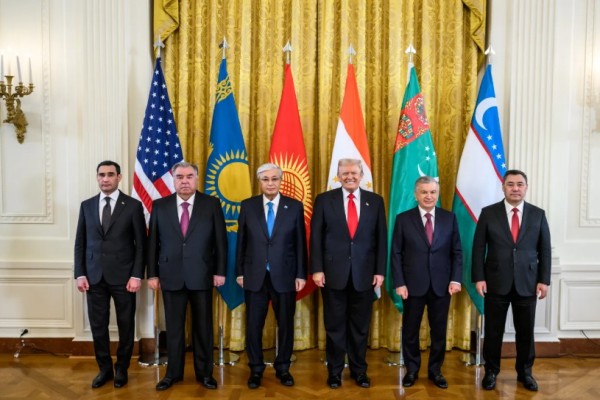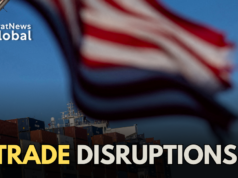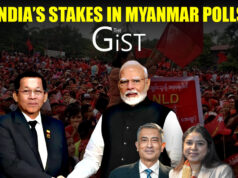
The last time all five Central Asian leaders met a U.S. president in Washington was never.
That changed on November 6, when the presidents of Kazakhstan, Kyrgyzstan, Tajikistan, Turkmenistan and Uzbekistan gathered in the American capital for the tenth C5+1 summit – the official dialogue between the United States and the five post-Soviet republics.
“It’s the first time the region’s leaders travel to Washington for a summit with President Trump carrying a diverse agenda that extends beyond trade topics,” The Moscow Times reported.
Trump, in his signature style, declared the meeting a “new chapter” in U.S.–Central Asia relations. He promised “fantastic numbers” and announced that Uzbekistan would invest over $100 billion in the American economy over the next decade—a figure about equal to the country’s GDP.
Whether that number was accurate or not, behind the flourish was a more serious shift.
For years, U.S. engagement with Central Asia tended to be reactive and security-led. Now, the focus is economic. The State Department’s joint statement emphasised trade, investment and cooperation on critical minerals — signalling a strategic effort to diversify supply chains that have long been dominated by China.
Central Asia is suddenly valuable.
Kazakhstan is among the world’s leading uranium producers, Uzbekistan and Kyrgyzstan hold rare-earth deposits, and Turkmenistan’s gas reserves make it a candidate for energy exports to Europe.
The summit’s agenda also featured discussions of the Trans-Caspian, or “Middle Corridor”—a route linking Central Asia to Europe via the Caspian Sea and the Caucasus, bypassing Russia.
Commerce Secretary Howard Lutnick announced deals spanning aviation, agriculture and resource processing: Uzbekistan will buy 22 Boeing aircraft, import American soybeans and meal, and collaborate with U.S. firms on rare earths and energy. Trump said these multi-billion-dollar projects would create jobs for Americans and deepen economic ties.
The meeting also fits a broader pattern: Central Asia is being courted not just by the U.S., but by other major powers.
India participates in two distinct regional frameworks that include the Central Asian republics: the Shanghai Cooperation Organization (SCO) and its own India–Central Asia, or “India + C5,” dialogue.
The SCO, which also includes China, Russia and Pakistan, serves as a broader platform for a multipolar world order, while the India + C5 format is a more focused partnership between New Delhi and the five Central Asian states — Kazakhstan, Kyrgyzstan, Tajikistan, Turkmenistan and Uzbekistan.
In June, India hosted the 4th India–Central Asia Dialogue in New Delhi. India and the five republics agreed to expand cooperation in rare earth exploration, digital infrastructure and the International North–South Transport Corridor linking India to Central Asia via Iran’s Chabahar port. They also reaffirmed a joint stance against terrorism and pledged deeper financial and infrastructural linkages.
In a new phase of global competition driven by supply chains and resources rather than ideology, this renewed attention offers fresh leverage to Central Asian nations.
Russia’s war in Ukraine has disrupted trade routes and exposed the risks of over-dependence on Moscow. China remains the dominant investor, but concerns about debt and dependency are rising. Having both Washington and New Delhi in the mix expands options and strengthens bargaining power.
Uzbekistan’s President Shavkat Mirziyoyev was especially enthusiastic, calling Trump “a president of peace” and suggesting only he could help end the war in Ukraine. His exuberant praise indicated that Tashkent is positioning itself as Washington’s gateway to Central Asia.
With its focus on deals, not lectures, the summit marked a clear departure from previous U.S. administrations that emphasised governance and human rights.
Geopolitically, the timing works in America’s favour. Russia’s grip on Central Asia has loosened since Kyiv, while China’s growing clout has stirred some pushback in the region.
However, as AsiaNews pointed out, the path to deeper U.S. involvement remains uncertain. The countries of the region still depend heavily on Russian trade routes and Chinese financing, while Washington’s promises have yet to materialise into sustained engagement. The article noted that “Central Asia has often been treated as a secondary theatre of U.S. foreign policy” and that whether this summit marks a true strategic shift or another short-lived initiative remains to be seen.
Central Asia is landlocked. Its main transit and energy routes still run through either Russia or China. The much-discussed Trans-Caspian corridor remains expensive and underdeveloped. Building the infrastructure and creating the investment climate to support large-scale cooperation will take years. Additionally, corruption, weak institutions and opaque legal systems remain obstacles to serious American investment.
India faces similar challenges. The New Delhi dialogue produced promising declarations, but trade volumes remain tiny—under US$2 billion annually. Cabinet ministers admitted logistics and infrastructure continue to lag.
But India’s strategy appears more steady and development-centred compared to Trump’s bold, rapid and deal-driven attitude.
Russia and China, meanwhile, are watching closely. Washington’s move adds a third player into what was a binary game — and for the Central Asians, that is an outcome in itself.
If Washington can translate promise into mining ventures, logistics hubs, transport corridors and more transparent investment regimes, it could shift the balance in the region.
But Trump’s grand announcements often outpace delivery, and Central Asian leaders know the difference between press-release figures and hard cash.
Even so, the symbolism matters. Hosting all five Central Asian presidents in Washington was itself a message—that geography no longer guarantees Russian dominance.
India’s parallel outreach indicates the outlines of a multipolar tussle shaping the region’s future.
Central Asia’s rulers, long adept at balancing great-power interests, are unlikely to pick sides. Their aim is clear: secure as much investment, technology and political cover as possible from all available partners.
In private, Central Asian diplomats say they welcome the competition. “It keeps everyone honest,” quipped one Kazakh official to a regional outlet. “When China builds a railway, Russia lowers its tariffs, and the U.S. offers an investment fund—it’s good for us.”
In a career spanning three decades and counting, Ramananda (Ram to his friends) has been the foreign editor of The Telegraph, Outlook Magazine and the New Indian Express. He helped set up rediff.com’s editorial operations in San Jose and New York, helmed sify.com, and was the founder editor of India.com.
His work has featured in national and international publications like the Al Jazeera Centre for Studies, Global Times and Ashahi Shimbun. But his one constant over all these years, he says, has been the attempt to understand rising India’s place in the world.
He can rustle up a mean salad, his oil-less pepper chicken is to die for, and all it takes is some beer and rhythm and blues to rock his soul.
Talk to him about foreign and strategic affairs, media, South Asia, China, and of course India.




